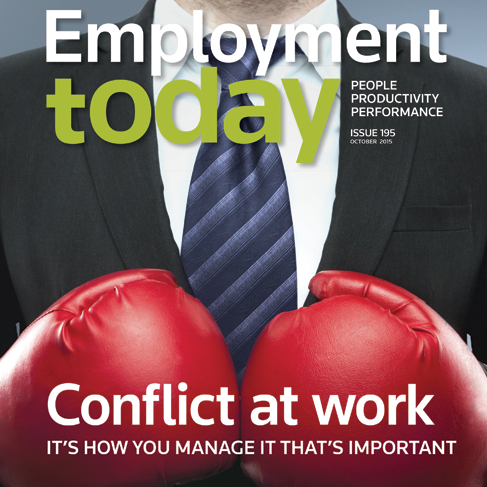Resolving conflict in the workplace
Even with sound systems in place, it’s unrealistic to think there won’t be conflict in the workplace. Judith Scott provides an overview of the more common types of employment disputes and sets out some ideas of how they might be managed.

The best way to resolve workplace conflict is to avoid it altogether by having sound HR systems, structure and processes in place. But it is, of course, unrealistic to think that if you do this you will avoid all workplace conflict. So, when conflict in the workplace does inevitably arise, how should you manage and resolve it in the most productive manner?
Disputes come in many forms. To set out ways to resolve workplace conflict in a short article is not realistic. Mediators, and others who specialise in this area, have usually spent years training and practising their skills in order to successfully resolve and manage disputes. They also bring an impartiality to the conflict. What I have endeavoured to do in this article is to give a brief overview of the more common types of employment disputes, set out some ideas of how they might be managed, and note where assistance can be found if you need it.
There are two main types of employment conflict—collective and individual. Collective conflict arises from the negotiation, interpretation or application of a collective employment agreement. The reason for individual conflict is usually more complex.
Collective conflict
Collective conflicts are best resolved by establishing a good working relationship between management and the relevant union. This will ensure that, when a collective employment agreement is entered into, all of the clauses are written in clear language and there is no room for misunderstandings about what a particular clause means.
When parties are in bargaining, there is a natural desire to reach agreement as quickly as possible. The final sessions are occasionally held late at night, or when there is a plane to catch. Drafting the clause the next morning can sometimes result in differences in interpretation or memory about what was agreed. Be realistic about timeframes for collective bargaining and make sure all of your team is committed for the time required.
It can be a long, slow process and one that requires commitment from managers who often have a busy schedule. Remember, the clause that you negotiate while under this sort of pressure may remain in place for years after the people at the bargaining table have moved on.
When conflict arises over the meaning of a clause, an early meeting to clarify exactly what the issues are, what sits behind them and what has caused the conflict should be arranged. An open-minded discussion with the union and the representatives early in the conflict can often solve the issues.
Conflict that occurs during the negotiation of a collective employment agreement can also be avoided, or more easily resolved, by good communication between the union and the employer. A mistake often made is to leave all major changes sought in the collective agreement until bargaining. Some employers see collective negotiations as an ideal time to introduce change, such as a new performance or salary fixing structure. Collective agreements should be reviewed regularly and, if they do not meet needs, discussions with the union and employees during the term, without the pressure of bargaining, is a more productive way to socialise necessary changes.
In recent times there has been a move from positional bargaining to interest-based bargaining. In my opinion, interest-based bargaining, while good in theory, runs into problems when the interests of the parties become diverse. Often, parties enter into interest-based talks determined and with their own interests clearly defined. Training is not a part of their process and the parties, because of their different roles, are unlikely to establish common interests.
It is all very well to say that the parties’ common interest is to have a financially viable business, to provide a customer-focused service or to increase the income of members, but how to achieve these goals, and what is the most important goal, is likely to raise different interests and priorities.
Joint problem solving, sometimes called high performance engagement (HPE), is a process that I am using more often to address these issues. This involves training the parties to work together to define and solve a common problem. The advantage is that relationships are established during the training, and the parties learn to talk to each other and to problem solve together. The process works best when the parties discuss plans and issues before they become a problem and enter the process without a preconceived idea of their bargaining position.
As a recent article about Air New Zealand’s use of HPE said: “It is based on the concept that ‘people closest to the problem find the solution’ and means union members and delegates are actively involved in looking at solutions.” For the process to work, it is essential to use an external trainer and facilitator, so it does require a financial and time commitment from both the union and the employer.
In my experience, this commitment is often less than traditional bargaining, and achieves better outcomes and more constructive ongoing relationships. One criticism of HPE, however, is that it is designed to be used in unionised workplaces. The joint problem solving process I use is slightly different as it can be structured to work in situations where the employees are not union members.
Individual conflict
Fewer than 20 percent of New Zealand workers belong to a union, with the majority of these people employed in the state sector. Workplaces are therefore more likely to be involved in individual conflict. As with collective conflict, the best way to manage this is by having sound, clearly defined and widely promulgated employment policies and practices in place and to manage conflict appropriately and speedily when it occurs.
Time taken at the beginning of a working relationship to ensure good employment practices, reference checking, clear employment agreements and job descriptions is time well spent in the avoidance of conflict. The establishment of good policies and procedures, so that staff and management are clear about their rights and responsibilities if conflict arises, will also assist.
If conflict does arise, manage it quickly, as close to the source of the conflict as possible. Training your managers and supervisors to not be afraid of conflict and to deal with it early will certainly be a good investment.
Individual conflict can arise in a number of areas. Bullying, harassment, conflict between two employees, performance issues and misunderstandings about rights and responsibilities are the most common areas of dispute. While there are common processes that can be used, each type of dispute benefits from a slightly different approach.
From my experience working as a mediator in the employment area, many individual conflict complaints occur out of annual performance review processes. These can result in claims of bullying or harassment. Problems with giving and receiving feedback is a common issue when conflict arises. Emphasis put on this area to ensure everyone involved has a clear understanding of what is required, along with appropriate review processes for employees who are concerned (about either the manner in which the process was carried out or the outcome they received), should prevent these claims arising.
If conflict does arise, reviewing the process that was undertaken, checking the nature of feedback given and ensuring that there is a process for an independent person to review the ratings and/or manner in which the feedback was given should be considered.
Conflict that results in bullying claims is another area that can cause major issues in the workplace, both for the accuser and the accused. When a claim is received, a timely, independent review should be conducted. The first part of managing an alleged bullying or harassment claim is to determine whether appropriate resources are available internally to complete a proper independent review. If they are not available, steps should be taken to contract an external reviewer to complete this process. If you contract an external person, preparing a brief to clarify the role and budget of the review will prevent any downstream surprises with the standard and nature of the review and its cost.
An internal review should be conducted by someone who is not only independent, but is seen as being so by the parties involved. They should conduct the review according to the principles of natural justice, giving both parties the chance to be heard and to give feedback. Any independent witnesses who can add value should also be interviewed.
There is a balance between talking to everyone who could possibly add something, and carrying out a timely, focused investigation. When the review has been completed, consideration should be given to how best to handle the findings and any potential fallout within the organisation.
Conflict between workers can be one of the most difficult areas to manage. Talking to them individually and then collectively (if they are willing to do so) to determine what has caused the issues is a good place to start. Questions for consideration include:
- When did the relationship go bad?
- What was the relationship like prior to the dispute?
- What led to the dispute?
- How do they see the dispute being resolved?
Once these questions have answers, consideration can be given to the steps that parties might take to rebuild the relationship.
Conflict can escalate quickly. In the worst cases, this results in expensive litigation and fallout that can be very damaging in workplaces. Getting help early to manage it, using either internal or external resources, is essential. The skills taught by Leadr and other mediation training organisations are good resources to consider using. Of particular importance are an impartial inquiry and open questions to determine what the problem is and the issues that sit behind the conflict.
Active listening, to truly hear the complainant’s issues, is a process that covers the principles of natural justice. If a person has a conflict of interest or is not impartial, then they should question whether they are the best person to be handling the conflict and whether some external assistance is needed.
Whether the conflict is collective or individual, external mediators are available to assist with managing it. The Ministry of Business Innovation and Employment has a free mediation service. There are also highly experienced and competent private mediators working in this area. The Ministry’s service is generally very good and is available for both ongoing employment relationships and those where there is no longer an employment relationship.
While the Ministry offers a good mediation service, as with a number of other free government services, users are unable to select who the mediator will be and there is often a waiting period to get a mediation date. Investing in a private mediator who is experienced in the employment area is usually money well spent, as you can choose a mediator to meet the particular nature of the conflict and usually get a timely resolution of the issues in dispute.
Workplace conflict is inevitable, it’s how you manage it that is important. Good communications, clear and transparent employment policies and good dispute resolution processes are a good place to start. And do not be afraid to use external support if you need it.
 JUDITH SCOTT is a mediation and employment investigation specialist who has played a major role in the resolution of a wide range of employment disputes. Visit www.judithscottassociates.co.nz
JUDITH SCOTT is a mediation and employment investigation specialist who has played a major role in the resolution of a wide range of employment disputes. Visit www.judithscottassociates.co.nz
Read more from Employment Today
This article, “Resolving conflict in the workplace”, is one of three free-to-browse from the current issue of our HR magazine: Employment Today.
Check out another article
Hardly a day goes by when Katrina isn’t bullied by her colleague Tracy. Jan Eggleton tells her story and looks at the impact of bullying in the workplace. Read more
Strategic thinking: Should HR pay attention?
Much of what has been done in the name of strategic management and strategic planning works against creativity and innovation, says Keith Macky. Instead, we should consider strategic thinking—it’s not rocket science, but it requires attention. Read more
Get a free sample copy of Employment Today
We'd like to give you a free sample copy of Employment Today. To request a copy, please click here
Thomson Reuters offers a full range of solutions for HR professionals – Find out more
